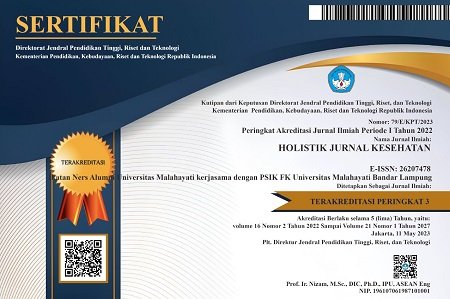Perceived benefit, perceived barrier dan dukungan sosial terhadap perawatan diri pasien setelah operasi Coronary Artery Bypass Graft (CABG)
Abstract
Background: CABG surgery is one of the surgical treatments for CHD and improves the patient's quality of life. However, patients who have undergone CABG remain at risk for ischemic events. Cardiovascular secondary prevention plays an important role to maintain the long-term patency of the graft, slowing the atherosclerotic process. Behavior change is influenced by a person's belief to change and support around him. The beliefs that are considered to have an effect on the pattern of behavior change are perceived benefits and perceived barriers.
Purpose: To determine the relationship between perceived benefit, perceived barrier, and social support to patient self-care after CABG surgery.
Method: Cross-sectional design, with a sample size of 75 respondents, inclusion criteria: CABG surgery patients more than 6 months, Age more than 30 years.
Results: From the analysis, there are four significant relationships with self-care, education p-value of 0.015, perceived benefit p-value of 0.001, perceived barrier with a p-value of 0.004, and social support p-value of 0.000. What is not significant is the age p-value of 0.631 and knowledge p-value of 0.418 Gender p-value of 0.357.
Conclusion: There is a significant relationship between perceived benefit, perceived barrier, and social support for patient self-care after CABG surgery.
Keywords: Perceived Benefit; Perceived Barriers; Social Support; Self Care; CABG.
Pendahuluan: Operasi CABG merupakan salah satu penanganan bedah pada PJK dan meningkatkan kualitas pasien kehidupan baik. Namun pasien yang telah menjalani CABG tetap berisiko untuk kejadian iskemik. Pencegahan sekunder kardiovaskular memainkan peran penting untuk mempertahankan jangka panjang patensi cangkok, memperlambat proses aterosklerotik. Perubahan perilaku dipengaruhi oleh keyakinan seseorang untuk berubah dan dukungan disekitarnya. Keyakinan yang dianggap berpengaruh terhadap pola perubahan perilaku adalah perceived benefit dan perceived barrier.
Tujuan: Untuk mengetahui hubungan perceived benefit, perceived barrier dan dukungan sosial terhadap perawatan diri pasien setelah operasi CABG.
Metode: Desain cross-secrtional, dengan jumlah sampel 75 responden, kriteria inklusi: Pasien operasi CABG lebih dari 6 bulan, Usia lebih dari 30 tahun.
Hasil: Dari analisis terdapat empat hubungan yang bermakna terhadap perawatan diri, didapatkan pendidikan nilai p 0,015, perceived benefit nilai p 0,001, perceived barrier dengan nilai p 0,004 , dan dukungan social nilai p 0,000. Yang tidak bermakna yaitu usia nilai p 0.631dan pengetahuan nilai p 0.418 Jenis kelamin nilai p 0,357.
Simpulan: Terdapat hubungan yang bermakna anatara perceived benefit, perceibved barrier, dan dukungan social terhadap perawatan diri pasien setelah operasi CABG.
Keywords
References
Athbi, H. A., & Hassan, H. B. (2019). Health beliefs of patients with coronary heart disease toward secondary prevention: the health beliefs model as a theoretical framework. Indian Journal of Public Health Research & Development, 1(1), 821-826.
Berhimpong, M. J. A., Rattu, A. J. M., & Pertiwi, J. M. (2020). Analisis Implementasi Aktivitas Fisik Berdasarkan Health Belief Model oleh Tenaga Kesehatan di Puskesmas. Indonesian Journal of Public Health and Community Medicine, 1(4), 54-62.
Han, H. R., Kang, J., Kim, K. B., Ryu, J. P., & Kim, M. T. (2007). Barriers to and strategies for recruiting Korean Americans for community-partnered health promotion research. Journal of Immigrant and Minority Health, 9(2), 137-146.
Harapan, E., & Ahmad, S., (2022). Komunikasi antarpribadi: Perilaku insani dalam organisasi pendidikan. PT. RajaGrafindo Persada-Rajawali Pers.
Harefa, D., & Telaumbanua, T. (2020). Belajar berpikir dan bertindak secara praktis dalam dunia pendidikan: kajian untuk akademis. Insan Cendekia Mandiri.
Hariyono, H. (2021). Peningkatan Kualitas Hidup Pasien Panyakit Jantung Koroner Dengan Self Regulatory Intervention.
Hendriana, E. C., & Jacobus, A. (2017). Implementasi pendidikan karakter di sekolah melalui keteladanan dan pembiasaan. JPDI (Jurnal Pendidikan Dasar Indonesia), 1(2), 25-29.
Huda, S. (2017). Hubungan antara efikasi diri dengan manajemen perawatan diri pada penderita hipertensi dewasa di kabupaten jepara. Jurnal Keperawatan dan Kesehatan Masyarakat Cendekia Utama, 6(1).
Huda, S., Amatayakul, A., & Karuncharernpanit, S. (2015). Factors associated with self-care management among adult people with hypertension in Jepara, Central Java, Indonesia. In The 3rd Annual Conference of the Asian Network for Public Opinion Research (ANPOR) Bangkok Thailand.
Jaarsma, T., Hill, L., Bayes‐Genis, A., La Rocca, H. P. B., Castiello, T., Čelutkienė, J., ... & Strömberg, A. (2021). Self‐care of heart failure patients: practical management recommendations from the Heart Failure Association of the European Society of Cardiology. European journal of heart failure, 23(1), 157-174.
Kementerian Kesehatan Republik Indonesia, (2019). Hari Jantung Sedunia (World Heart Day): Your Heart is Our Heart Too. P2PTM Kemenkes RI. diakses dari: http://p2ptm.kemkes.go.id/kegiatan-p2ptm/pusat-/hari-jantung-sedunia-world-heart-day-your-heart-is-our-heart-too.
Kristinawati, B., & Khasanah, R. N. (2019). Hubungan Pelaksanaan Edukasi dengan Kemampuan Self Care Management Pasien Gagal Jantung. Proceeding of The URECOL, 496-503.
Kulik, A., Ruel, M., Jneid, H., Ferguson, T. B., Hiratzka, L. F., Ikonomidis, J. S., & Zimmerman, L. (2015). Secondary prevention after coronary artery bypass graft surgery: a scientific statement from the American Heart Association. Circulation, 131(10), 927-964.
LeMone, P., Burke, K., Levett-Jones, T., Dwyer, T., Moxham, L., Reid-Searl, K., & Raymond, D. (2014). Medical-surgical nursing: Critical thinking for person-centred care.
Notoatmodjo, S. (2010). Ilmu perilaku kesehatan.
Notoatmodjo, S. (2014). IPKJRC (2015). Ilmu Perilaku Kesehatan. Jakarta: Rineka Cipta. Biomass Chem Eng, 49(23-6).
O’Neil, A., Scovelle, A. J., Milner, A. J., & Kavanagh, A. (2018). Gender/sex as a social determinant of cardiovascular risk. Circulation, 137(8), 854-864.
Paquin, A., Poirier, P., Beaudoin, J., & Piche, M. E. (2020). Secondary prevention after CABG: do new agents change the paradigm?. Current Opinion in Cardiology, 35(6), 664-672.
Riegel, B., Moser, D. K., Buck, H. G., Dickson, V. V., Dunbar, S. B., Lee, C. S., & Webber, D. E. (2017). American Heart Association Council on Cardiovascular and Stroke Nursing; Council on Peripheral Vascular Disease; and Council on Quality of Care and Outcomes Research. Self-care for the prevention and management of cardiovascular disease and stroke: a scientific statement for healthcare professionals from the American Heart Association. J Am Heart Assoc, 6(9), e006997.
Rodgers, J. L., Jones, J., Bolleddu, S. I., Vanthenapalli, S., Rodgers, L. E., Shah, K., & Panguluri, S. K. (2019). Cardiovascular risks associated with gender and aging. Journal of cardiovascular development and disease, 6(2), 19.
Rupprecht, L., Schmid, C., Debl, K., Lunz, D., Flörchinger, B., & Keyser, A. (2019). Impact of coronary angiography early after CABG for suspected postoperative myocardial ischemia. Journal of Cardiothoracic Surgery, 14(1), 1-7.
Schmidt-RioValle, J., Abu Ejheisheh, M., Membrive-Jiménez, M. J., Suleiman-Martos, N., Albendín-García, L., Correa-Rodríguez, M., & Gómez-Urquiza, J. L. (2020). Quality of life after coronary artery bypass surgery: a systematic review and meta-analysis. International journal of environmental research and public health, 17(22), 8439.
Shin, E. S., Hwang, S. Y., Jeong, M. H., & Lee, E. S. (2013). Relationships of factors affecting self-care compliance in acute coronary syndrome patients following percutaneous coronary intervention. Asian Nursing Research, 7(4), 205-211.
Soltani, M., Pourahmadi, V., Mirzaei, A., & Sheikhzadeh, H. (2019). Deep learning-based channel estimation. IEEE Communications Letters, 23(4), 652-655.
Sukarna, R. A. D. E. (2017). Hubungan antara..., R Ade Sukarna, FIK UI, 2017.
Syachroni, S. S., Syarifah, U., Kom, S., & Yulianto, A. (2013). Riset Kesehatan Dasar.
Tahan, A. I. (2019). Pemenuhan Kebutuhan Self Care Pada Ny. A. L Yang Menderita Hiv/Aids Di Ruang Teratai RSUD Prof. Dr. WZ Johannes Kupang Mei 2019 (Doctoral dissertation, Poltekkes Kemenkes Kupang).
Vaglio, J., Conard, M., Poston, W. S., O'Keefe, J., Haddock, C. K., House, J., & Spertus, J. A. (2004). Testing the performance of the ENRICHD Social Support Instrument in cardiac patients. Health and quality of life outcomes, 2(1), 1-5.
Vazini, H., & Barati, M. (2014). The health belief model and self-care behaviors among type 2 diabetic patients. Iranian Journal of Diabetes and Obesity, 6(3), 107-113.
Winham, D. M., & Jones, K. M. (2011). Knowledge of young African American adults about heart disease: a cross-sectional survey. BMC Public Health, 11(1), 1-11.
DOI: https://doi.org/10.33024/hjk.v16i4.7392
Refbacks
- There are currently no refbacks.
Copyright (c) 2022 Holistik Jurnal Kesehatan

This work is licensed under a Creative Commons Attribution-NonCommercial 4.0 International License.














